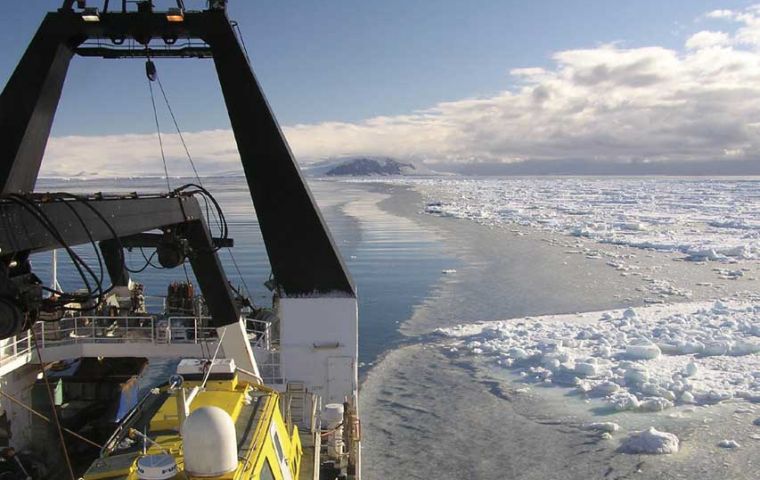MercoPress. South Atlantic News Agency
Incredible scientific finds in Ross Sea cruise survey
 <i>RV Tangaroa</i>, working in the Ross Sea.
<i>RV Tangaroa</i>, working in the Ross Sea. Scientists who conducted the most comprehensive survey to date of Antarctic waters close to New Zealand were surprised by the size of some specimens found, including jellyfish with 12-foot tentacles and 2-foot-wide starfish, and fields of ”sea lilies
The 2,000-mile journey aboard the Tangaroathrough the Ross Sea that ended last week has also potentially turned up several new species, including as many as eight new mollusks. Scientists collected over 30,000 specimens in their eight week journey. The purpose of the research was to provide information from the Southern Ocean and Ross environment to further monitor the effects of climate change in the area, while at the same time they focused on the biodiversity and collected samples from the sea floor to the sea surface and captured images of the sea bed up to 4000 m depth. It's "exciting when you come across a new species," said Chris Jones, a fisheries scientist at the U.S. National Oceanic and Atmospheric Administration. "All the fish people go nuts about that â€" but you have to take it with a grain of salt." The finds must still be reviewed by experts to determine if they are in fact new, said Stu Hanchet, a fisheries scientist at New Zealand's National Institute of Water and Atmospheric Research. But beyond the discovery of new species, scientists said the survey, the most comprehensive to date in the Ross Sea, turned up other surprises. Hanchet singled out the discovery of "fields" of sea lilies that stretched for hundreds of yards across the ocean floor. "Some of these big meadows of sea lilies I don't think anybody has seen before," Hanchet said. Previously only small-scale scientific samplings have been staged in the Ross Sea. The survey was part of the International Polar Year program involving 23 countries in 11 voyages to survey marine life and habitats around Antarctica. Large sea spiders, jellyfish with 12-foot tentacles, huge sea snails and starfish the size of big food platters were found during a 50-day voyage, marine scientist Don Robertson said. Cold temperatures, a small number of predators, high levels of oxygen in the sea water and even longevity could explain the size of some specimens, said marine scientist Don Robertson, a scientist with New Zealand's NIWA. Stefano Schiaparelli, a mollusk specialist at Italy's National Antarctic Museum in Genoa, said he thought the find would yield at least eight new mollusks. "This is a new brick in the wall of Antarctic knowledge" Schiaparelli said.

![“Working directly with President [Donald] Trump and Congress, we accomplished what no one else could,” Patel stressed](/data/cache/noticias/108417/130x80/fbi.jpg)


Top Comments
Disclaimer & comment rulesCommenting for this story is now closed.
If you have a Facebook account, become a fan and comment on our Facebook Page!